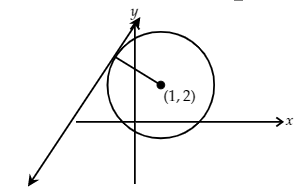
Find the equation of the circle with centre (1, 2) and tangent \[x + y - 5 = 0\]
A.\[{x^2} + {y^2} + 2x - 4y + 6 = 0\]
B. \[{x^2} + {y^2} - 2x - 4y + 3 = 0\]
C. \[{x^2} + {y^2} - 2x - 4y - 8 = 0\]
D. \[{x^2} + {y^2} - 2x - 4y + 8 = 0\]
Answer
218.7k+ views
Hints First draw the diagram of the circle with a tangent line to have a clear concept. Use the formula of perpendicular distance from a line to a point to obtain the perpendicular distance from a line \[x + y - 5 = 0\] to a point (1, 2). The positive value of the distance is the radius of the circle. By using the standard form of circle, we will find the equation of circle.
Formula used
The formula of perpendicular distance of a line \[ax + by + c = 0\] to a point \[({x_1},{y_1})\]is
\[\dfrac{{a{x_1} + b{y_1} + c}}{{\sqrt {{a^2} + {b^2}} }}\] .
The general equation of a circle with centre (h, k) and radius r is
\[{\left( {x - h} \right)^2} + {\left( {y - k} \right)^2} = {r^2}\] .
Complete step by step solution
The diagram of the given problem is,

Image: Circle with tangent
Therefore, to obtain the radius of the given circle obtain the perpendicular distance from the given line to the centre.
So, the perpendicular distance is,
\[\dfrac{{1.1 + 1.2 - 5}}{{\sqrt {{1^2} + {1^2}} }}\]
\[ = - \dfrac{2}{{\sqrt 2 }}\]
\[ = - \sqrt 2 \] , but radius cannot be negative.
Therefore, the radius is \[\sqrt 2 .\]
We know the general equation of a circle with centre (h, k) and radius r is
\[{\left( {x - h} \right)^2} + {\left( {y - k} \right)^2} = {r^2}\] .
So, the equation of the circle with radius (1, 2) and radius \[\sqrt 2 \] is,
\[{\left( {x - 1} \right)^2} + {\left( {y - 2} \right)^2} = {\left( {\sqrt 2 } \right)^2}\]
\[{x^2} - 2x + 1 + {y^2} - 4y + 4 = 2\]
\[{x^2} + {y^2} - 2x - 4y + 3 = 0\]
The correct option is B.
Note The diagram is the important part in this type of questions. Without the diagram it is not clear that the perpendicular distance from the centre to the tangent line is the radius of the circle. So, draw a diagram first to understand the question clearly.
Formula used
The formula of perpendicular distance of a line \[ax + by + c = 0\] to a point \[({x_1},{y_1})\]is
\[\dfrac{{a{x_1} + b{y_1} + c}}{{\sqrt {{a^2} + {b^2}} }}\] .
The general equation of a circle with centre (h, k) and radius r is
\[{\left( {x - h} \right)^2} + {\left( {y - k} \right)^2} = {r^2}\] .
Complete step by step solution
The diagram of the given problem is,

Image: Circle with tangent
Therefore, to obtain the radius of the given circle obtain the perpendicular distance from the given line to the centre.
So, the perpendicular distance is,
\[\dfrac{{1.1 + 1.2 - 5}}{{\sqrt {{1^2} + {1^2}} }}\]
\[ = - \dfrac{2}{{\sqrt 2 }}\]
\[ = - \sqrt 2 \] , but radius cannot be negative.
Therefore, the radius is \[\sqrt 2 .\]
We know the general equation of a circle with centre (h, k) and radius r is
\[{\left( {x - h} \right)^2} + {\left( {y - k} \right)^2} = {r^2}\] .
So, the equation of the circle with radius (1, 2) and radius \[\sqrt 2 \] is,
\[{\left( {x - 1} \right)^2} + {\left( {y - 2} \right)^2} = {\left( {\sqrt 2 } \right)^2}\]
\[{x^2} - 2x + 1 + {y^2} - 4y + 4 = 2\]
\[{x^2} + {y^2} - 2x - 4y + 3 = 0\]
The correct option is B.
Note The diagram is the important part in this type of questions. Without the diagram it is not clear that the perpendicular distance from the centre to the tangent line is the radius of the circle. So, draw a diagram first to understand the question clearly.
Recently Updated Pages
The maximum number of equivalence relations on the-class-11-maths-JEE_Main

A train is going from London to Cambridge stops at class 11 maths JEE_Main

Find the reminder when 798 is divided by 5 class 11 maths JEE_Main

An aeroplane left 50 minutes later than its schedu-class-11-maths-JEE_Main

A man on the top of a vertical observation tower o-class-11-maths-JEE_Main

In an election there are 8 candidates out of which class 11 maths JEE_Main

Trending doubts
JEE Main 2026: Application Form Open, Exam Dates, Syllabus, Eligibility & Question Papers

Derivation of Equation of Trajectory Explained for Students

Hybridisation in Chemistry – Concept, Types & Applications

Understanding the Angle of Deviation in a Prism

Understanding Collisions: Types and Examples for Students

Understanding Atomic Structure for Beginners

Other Pages
JEE Advanced Marks vs Ranks 2025: Understanding Category-wise Qualifying Marks and Previous Year Cut-offs

NCERT Solutions for Class 11 Maths Chapter 10 Conic Sections

NCERT Solutions for Class 11 Maths Chapter 9 Straight Lines

NCERT Solutions For Class 11 Maths Chapter 8 Sequences And Series

How to Convert a Galvanometer into an Ammeter or Voltmeter

NCERT Solutions For Class 11 Maths Chapter 12 Limits And Derivatives




